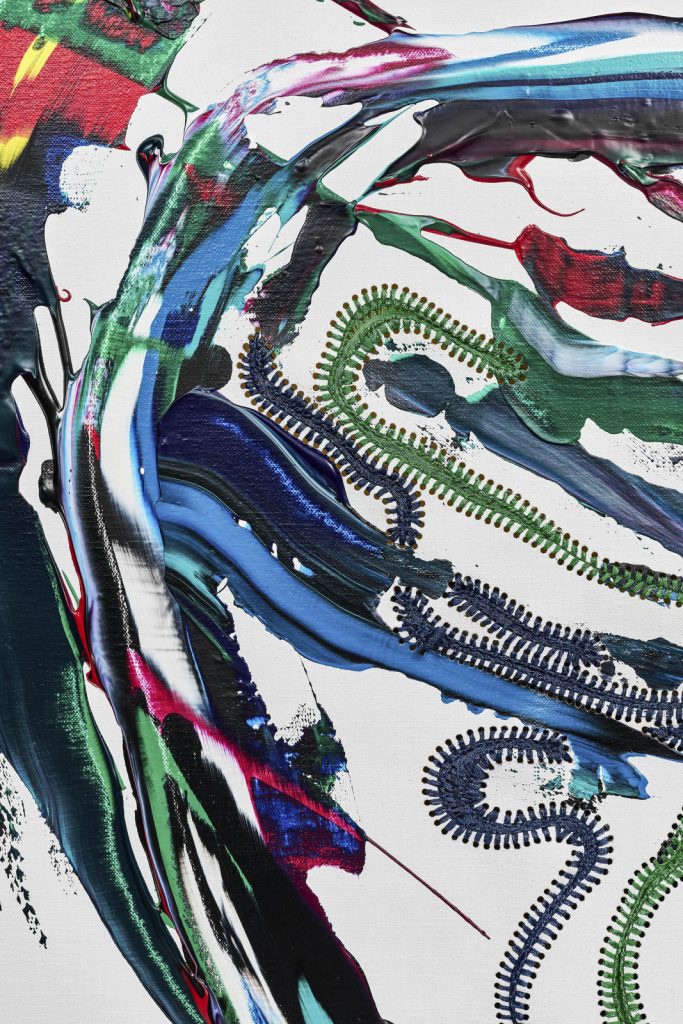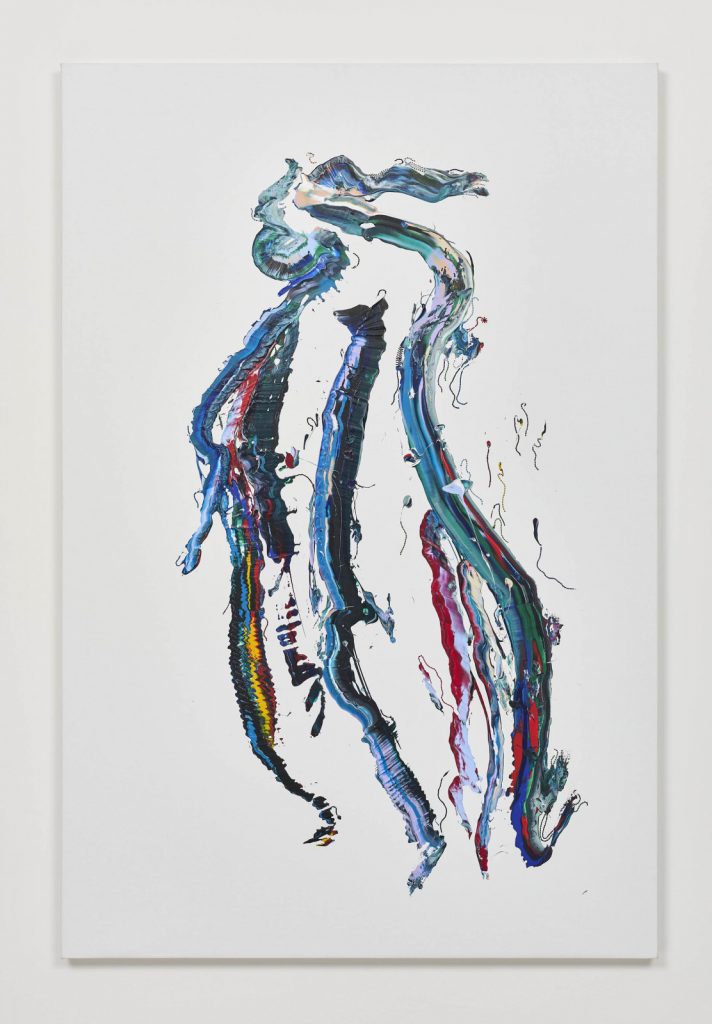Nicholas Hlobo Intabamlilo 2022 Acrylic paint, leather and ribbons on Belgium linen canvas 160 x 250 x 7 cm Photo: Anthea Pokroy
Before I arrived at his studio last week, Nicholas Hlobo fell on his face while attempting to do a backbend. He greeted me apologetically, swollen and scratched, and explained that he’d fallen because he’d closed his eyes too quickly.
“It was good,” he assures me, “Like kids, we have to fall down and get bruised to learn. When you’re guided, you become a cupcake.”
This way of thinking has some resonance with the title of Hlobo’s latest exhibition, Yongamela Ubumnyama, which opened to the public at the Goodman Gallery in Johannesburg on 27 August.
Yongamela Ubumnyama loosely translates as “overcome the darkness”, which is perhaps what the artist was aiming for as he closed his eyes and launched his body backwards. Hlobo’s work demonstrates a tension between composure and collapse that can be applied to South Africa’s transition to democracy — a process that began around the time the artist came of age.
Personhood — what it means to be a person in relation to other people, to establish an identity for yourself in spite of, or because of, the circumstances of your birth — might also be described as a consistent effort to hold a collection of disparate parts together in the hope that they remain in position.
“The subjects explored are laden with tension. Being myself, born into my family, discovering there is an oddness in me, that’s my gender identity, my sexuality, being black, being Xhosa — you have your own baggage. You can never detach that from yourself.”
Yongamela Ubumnyama consists mostly of bright white canvases whose stretched skins have been plastered with thick, brash acrylic colour. The loose, erratic slaps of paint extend into tightly stitched ribbon tendrils that spread and curl across the pristine plane.
The canvas is cut, punctured and then sutured back together with the kind of gaudy ribbon usually found fastened to the hair of little girls and prized animals.
The surface remains taut in some areas, but bulges and protrudes in others, reaching out and releasing (on occasion) a light shower of frayed and twisted ribbon ends. Gashes and holes in the canvas gape (with a tidy border) or are patched with leather.
I find these paintings hard to look at — they repel my gaze in a way that feels engineered. The colour is garish and produces an unsettling effect against the clinical canvas. There are moments when the kaleidoscopic colours move together in ecstatic synchronisation, but the application of paint is unrestrained and random.
 Nicholas Hlobo Intabamlilo 2022 Acrylic paint, leather and ribbons on Belgium linen canvas 160 x 250 x 7 cm Photo: Anthea Pokroy
Nicholas Hlobo Intabamlilo 2022 Acrylic paint, leather and ribbons on Belgium linen canvas 160 x 250 x 7 cm Photo: Anthea Pokroy
Hlobo mixes his colours “directly on the canvas, as opposed to on the side … the process is in charge, [I] let it be in control”.
Painting is a recent development in his practice, the product of pandemic restrictions, “two years of darkness”, that led to long stretches of time spent alone in the studio when he could experiment without deadlines.
Hlobo has worked with canvas for years, though earlier works involved minimal paint and almost no colour. He used white or neutral tones of ribbon and other materials to stitch up careful tears in the white canvas.
“I was trying to work with no colour, play with something that is like a ghost, to see the forms without the colour.” He later moved on to tea-stain drawings (the Tate has one): “I use tea as well as watercolours, lay the paper and then brew my tea and then just pour, pour and pour.”
In Yongamela Ubumnyama, acrylic colour dominates the various compositions, with the snaking contours of ribbon and canvas becoming apparent on closer inspection.
For Hlobo, the transformation of the canvas represents a kind of claiming or annexure: “I see it as a piece of fresh ground that was peaceful until I decided to disturb it.”
There is an obvious colonial inference in this language, where the routes and pathways of paint and stitches revise or appropriate a compulsion to seize, chart and define. The work’s meandering lines also imply a searching, wandering impulse that ties in with the artist’s way of speaking and telling stories.
In my long, meandering discussion with Hlobo, he used an idiom to introduce almost every subject. He segued through anecdotes about owning your mistakes: “Your fart didn’t have any presence,” and reckoning with half-truths: “Bring flesh to the bones, so that I can admire the beast.”
When these expressions or metaphors aren’t drawn from isiXhosa and folklore they are embellished, invented or “expondered” by Hlobo, whose interest in narrative underlies his practice. “I’m curious how words are formed. Language doesn’t stay put; it has to move.”
Language, like canvas and ribbon, is a compound or composite medium in which multiple threads are pulled and held together. Like canvas and ribbon, language is manipulated in the artist’s hands, and it is made to perform in unexpected ways.
During our conversation, Hlobo moves between isiXhosa and English (for my benefit): “Isisila senkhukhu sibonwa mhla ligquthayo — you only see the tail of a chicken (the anus, the underside) when it’s windy. The feathers on the top are what makes the chicken beautiful, but when it’s windy, you see what lies hidden.” A person’s character reveals itself in adversity.
The titles often refer to animals, drawing their forms or characters into the reading of his work. Ufudo (The Turtle) is relatively easily discerned in an arc of delirious colour. The movements in Umxhentso Wesikhova (The Dance of the Owl) express a suitable ambiguity.
Hlobo has consistently titled his works in isiXhosa, a move that ensures fragments of the language, its imagery and mythologies are inserted into the discourse of the extensive list of local and international galleries, institutions and private collections that exhibit and acquire his work.
 Nicholas Hlobo Intabamlilo 2022 Acrylic paint, leather and ribbons on Belgium linen canvas 160 x 250 x 7 cm Photo: Anthea Pokroy
Nicholas Hlobo Intabamlilo 2022 Acrylic paint, leather and ribbons on Belgium linen canvas 160 x 250 x 7 cm Photo: Anthea Pokroy
The prolific and widely celebrated artist is probably best known for his sculptural installations, which assemble leather, ribbon, rubber, defunct mechanical objects and other detritus. One such work, Waxhotyiswa Engekakhawulwa (He was Empowered Before Conception) from 2017, is included in Yongamela Ubumnyama. It comprises leather, wood, ribbons, a skull and a heavy steel mechanism which I read is an old hand-operated drill.
Undulating folds of leather are highlighted with mostly orange ribbons, whose ends are splayed around like streamers after a birthday party. The leather “body” of this creature either extends from, or is consumed by, the steel mechanism, which is topped with a horned skull.
Hlobo’s work often combines soft, sensual bodily textures and forms with aggressive techniques and heavy-duty materials. It is physically coded with carnal and gendered associations, violence, tenderness, rupture and repair. There is an aesthetic logic here that introduces a range of topical social and political subjects: the fluidity of gender and sexuality; compound and changeable personhood; the complexity of identity in the wake of the failed rainbow narrative.
The physicality and affective nature of this logic is what distinguishes the work, lifting it out of a didactic space and into a speculative realm. Its materials seduce and disturb, its forms hint at recognisable figures but refuse classification and, in the context of the precious space of contemporary art, its tacky colours invite offence.
While the artist has contextualised his move to painting as a result of the time and space afforded him by lockdown.
His previous exhibition in Joburg, Isango (2019), featured loopy tangles of copper piping that were strikingly minimal in comparison to the voluptuous installations for which he has received widespread recognition.
A glimpse at his record of exhibition-making over the past two decades reveals a practice intent on turning itself over, regularly.
“I don’t want to stand looking at ‘now’ while others are beginning to till the soil for tomorrow. Looking at ‘now’, you are a fool at the bus stop.”
Hlobo uses the term “self-inventory” to designate the difficult and ongoing work of understanding, questioning and choosing who and how you are.
“I don’t think that process is ever finished; it’s never done. When they do that last ritual, I think that’s when it’s done.”
The artist is not afraid to fall on his face. This is a rare quality that has probably played a role in his success.
“Even the reeds on the bank of the river, if it’s in flood, they get uprooted, land somewhere
and regenerate,” he says.
Yongamela Ubumnyama is Hlobo’s first show with the Goodman Gallery and the inaugural exhibition in its newly renovated premises. Like many who drive past the former car showroom on Jan Smuts Avenue daily, I was eager to experience the rejuvenated space since the Paintfellas’ sign first obscured the gallery’s logo in the front window several weeks ago. The fact that Hlobo is now a “paintfella” is coincidental and has nothing whatsoever to do with the renovation.
A quick look at the gallery’s exhibition record and stable of artists will confirm a concerted effort at inclusivity — beyond Paintfellas, that is.
The new Goodman Gallery sports a wide, light-filled entrance space with seating, a coffee machine and a section for gallery merch. This leads onto an angular antechamber and then onto a large central exhibition area that is a distinctive move away from the nooks and crannies that previously defined the space. A smaller room in the rear offers a nice, less exposed space for looking.
Yongamela Ubumnyama by Nicholas Hlobo is on exhibition at Goodman Gallery Johannesburg until 1 October.